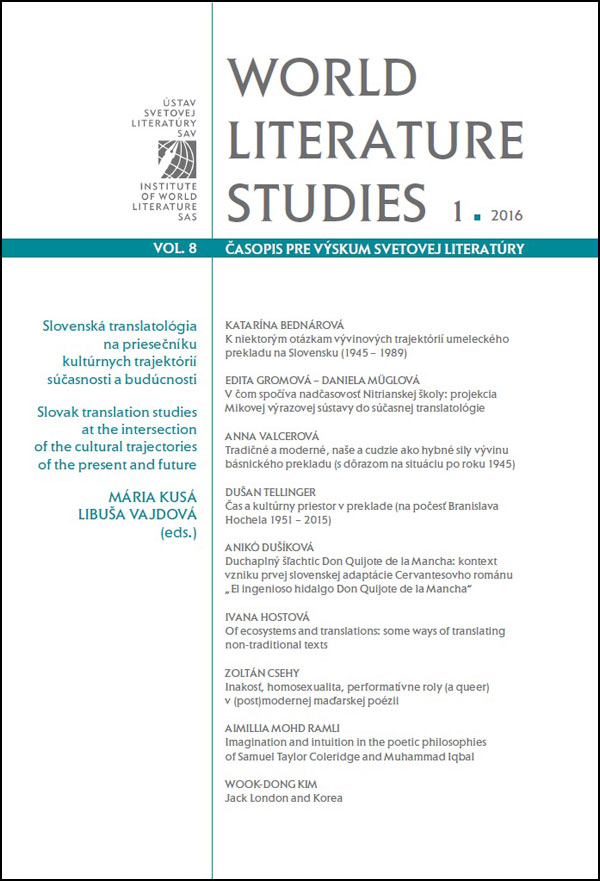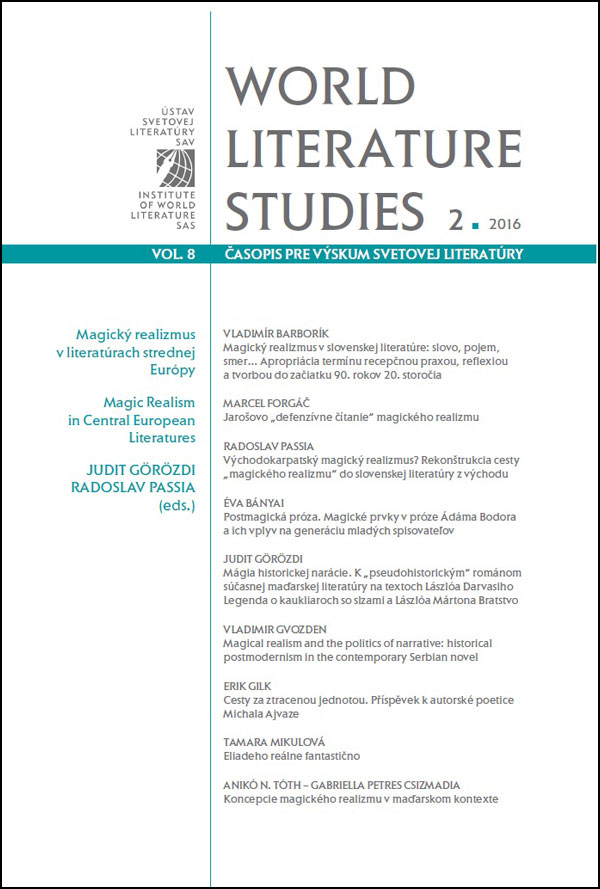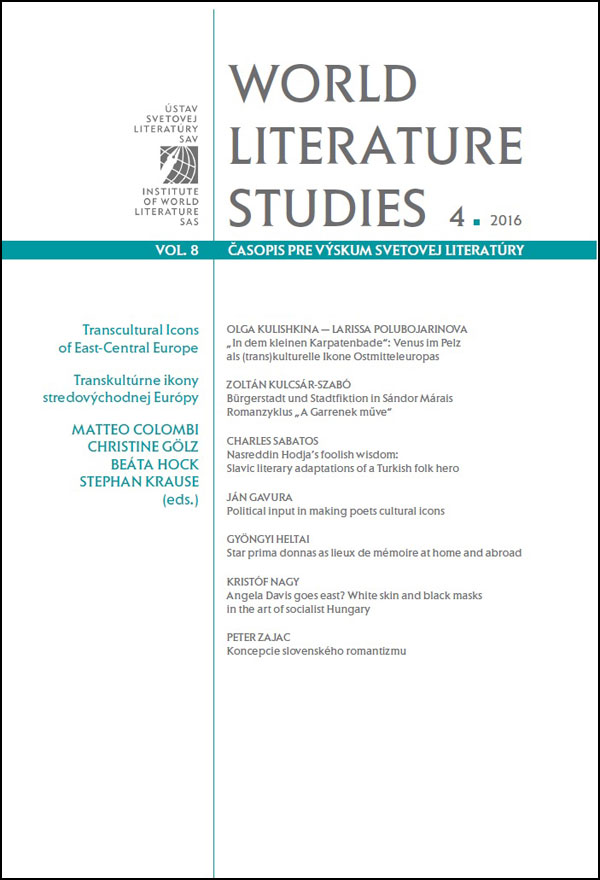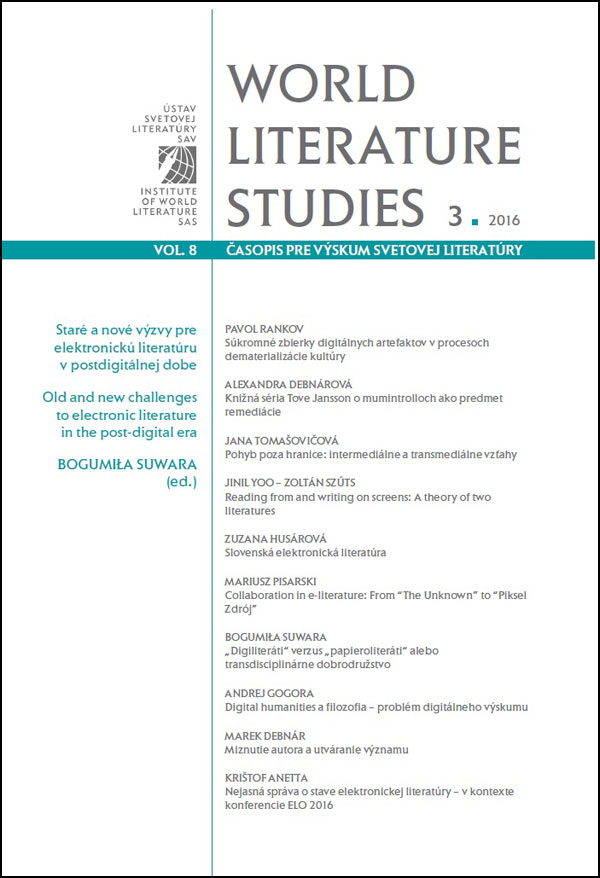-
Slovak translation studies at the intersection of the cultural trajectories of the present and future
eds. Mária Kusá, Libuša Vajdová

This issue’s topic raises awareness of contemporary Slovak translation studies and opens up a new perspective on the state of research, focusing on topics that clarify questions around the reflection of history and theory of translation and synthetize methodological inspirations from Slovak and foreign experiences. The authors identify and name the functions and meanings of the relevant processes operating in both Slovak and international cultural spaces. Translation has traditionally had a special place in this intersection of cultural trajectories, bringing forth the need for its reflection. The articles show how Slovak scholars approach the application of some key concepts currently discussed in translation studies debates in the West.
Download PDF (WLS_1_2016).
OBSAH / CONTENTS
e d i t o r i á l / e d i t o r i a l
Mária Kusá – Libuša Vajdová
Slovenská translatológia na priesečníku kultúrnych trajektórií súčasnosti a budúcnosti ■ 2 (go to article)š t ú d i e – t é m a / a r t i c l e s – t o p i c
Katarína Bednárová
K niektorým otázkam vývinových trajektórií umeleckého prekladu na Slovensku (1945 – 1989) ■ 3 (go to article)
Edita Gromová – Daniela Müglová
V čom spočíva nadčasovosť Nitrianskej školy: projekcia Mikovej výrazovej sústavy do súčasnej translatológie ■ 24 (go to article)
Anna Valcerová
Tradičné a moderné, naše a cudzie ako hybné sily vývinu básnického prekladu (s dôrazom na situáciu po roku 1945) ■ 35 (go to article)
Dušan Tellinger
Čas a kultúrny priestor v preklade (na počesť Branislava Hochela 1951 – 2015) ■ 49 (go to article)
Anikó Dušíková
Duchaplný šľachtic Don Quijote de la Mancha: kontext vzniku prvej slovenskej adaptácie Cervantesovho románu „El ingenioso hidalgo Don Quijote de la Mancha“ ■ 61 (go to article)d i s k u s i a / d i s c u s s i o n
Ivana Hostová
Of ecosystems and translations: some ways of translating non-traditional texts ■ 74 (go to article)š t ú d i e / a r t i c l e s
Zoltán Csehy
Inakosť, homosexualita, performatívne roly (a queer) v (post)modernej maďarskej poézii ■ 86 (go to article)
Aimillia Mohd Ramli
Imagination and intuition in the poetic philosophies of Samuel Taylor Coleridge and Muhammad Iqbal ■ 98 (go to article)
Wook-Dong Kim
Jack London and Korea ■ 112 (go to article)r e c e n z i e / b o o k r e v i e w s
Oľga Kovačičová – Mária Kusá (eds.): Slovník slovenských prekladateľov umeleckej literatúry. 20. storočie. A – K (Anton Eliáš) ■ 127 (go to article)
Libuša Vajdová a kol.: Myslenie o preklade na Slovensku (Milan Potočár) ■ 129 (go to article)
Hans-Thies Lehmann: Tragödie und dramatisches Theater (Anna Fosse) ■ 131 (go to article)
Daniela Blahutková – Miloš Ševčík: Patočkovy interpretace literatury (Marcel Forgáč) ■ 133 (go to article)
Roman Jakobson: Moudrost starých Čechů. Komentovaná edice s navazující exilovou polemikou (Róbert Gáfrik) ■ 135 (go to article) -
Magic Realism in Central European Literatures
eds. Judit Görözdi, Radoslav Passia

This issue maps possible filiations between magical realism and central European literatures. The authors of the issue focus predominantly on Slovak but also Hungarian, Czech, and Romanian literature. They try to encompass several sources of “magic realism” in the central European cultural milieu. Individual articles show that in addition to the influence of significant works of world literature classified within magic realism, local inspirations and own narrative traditions play an important role in the domestication of magic-realism strategies. It can thus be claimed that several original authorial, national or “areal” models of magic-realistic narratives have emerged in central Europe.
Download PDF (WLS_2_2016).
OBSAH / CONTENTS
e d i t o r i á l / e d i t o r i a l
Judit Görözdi – Radoslav Passia
Magický realizmus v literatúrach strednej Európy ■ 2 (go to article)š t ú d i e / a r t i c l e s
Vladimír Barborík
Magický realizmus v slovenskej literatúre: slovo, pojem, smer… Apropriácia termínu recepčnou praxou, reflexiou a tvorbou do začiatku 90. rokov 20. storočia ■ 3 (go to article)
Marcel Forgáč
Jarošovo „defenzívne čítanie“ magického realizmu ■ 18 (go to article)
Radoslav Passia
Východokarpatský magický realizmus? Rekonštrukcia cesty „magického realizmu“ do slovenskej literatúry z východu ■ 29 (go to article)
Éva Bányai
Postmagická próza. Magické prvky v próze Ádáma Bodora a ich vplyv na generáciu mladých spisovateľov ■ 40 (go to article)
Judit Görözdi
Mágia historickej narácie. K „pseudohistorickým“ románom súčasnej maďarskej literatúry na textoch Lászlóa Darvasiho Legenda o kaukliaroch so slzami a Lászlóa Mártona Bratstvo ■ 50 (go to article)
Vladimir Gvozden
Magical realism and the politics of narrative: historical postmodernism in the contemporary Serbian novel ■ 64 (go to article)
Erik Gilk
Cesty za ztracenou jednotou. Příspěvek k autorské poetice Michala Ajvaze ■ 76 (go to article)
Tamara Mikulová
Eliadeho reálne fantastično ■ 89 (go to article)m a t e r i á l y / m a t e r i a l s
Anikó N. Tóth – Gabriella Petres Csizmadia
Koncepcie magického realizmu v maďarskom kontexte ■ 97 (go to article)r e c e n z i e / b o o k r e v i e w s
Magdolna Balogh (ed.): Választások és kényszerek. Zsidó önkép és közösségtudat Közép-Európában (Irodalom- és kultúrtörténeti tanulmányok) (Pál Száz) ■ 104 (go to article)
Zoltán Csehy: Szodoma és környéke. Homoszocialitás, barátságretorika és queer irányulások a magyar költészetben (József Keserű) ■ 107 (go to article)
Magda Kučerková (ed.): Duchovná cesta a jej podoby v literatúre (Ján Knapík) ■ 109 (go to article)
Josef Opatrný – Michal Zourek – Lucia Majlátová – Matyáš Pelant: Las relaciones entre Checoslovaquia y América Latina 1945 – 1989 en los archivos de la República Checa (Nataša Burcinová) ■ 111 (go to article)
Mariana Čechová – Ľubomír Plesník: Tematické algoritmy a existenciálne stratégie v Oceáne príbehov (Lucia Biznárová) ■ 113 (go to article) -
Old and new challenges to electronic literature in the post-digital era
The post-digital era is a time of the crossing, interference and interaction of multiple processes that take place in the Gutenberg galaxy on the one hand and in the sphere of remediated (analogue and digital) culture on the other. The theme of this issue focuses on both the old and the most recent concepts of research in digital literature and culture. It analyses the rapidly changing ideas and equally rapidly changing cultural phenomena. The aim of this issue is not only to verify several prematurely rejected or overstated hypotheses but also to reflect on real cultural phenomena and their accompanying processes in today’s post-digital age.
Download PDF (WLS_3_2016).
OBSAH / CONTENTS
e d i t o r i á l / e d i t o r i a l
Bogumiła Suwara
Staré a nové výzvy pre elektronickú literatúru v postdigitálnej dobe ■ 2 (go to article)š t ú d i e / a r t i c l e s
Pavol Rankov
Súkromné zbierky digitálnych artefaktov v procesoch dematerializácie kultúry ■ 3 (go to article)
Alexandra Debnárová
Knižná séria Tove Jansson o mumintrolloch ako predmet remediácie ■ 15 (go to article)
Jana Tomašovičová
Pohyb poza hranice: intermediálne a transmediálne vzťahy ■ 29 (go to article)
Jinil Yoo – Zoltán Szűts
Reading from and writing on screens: A theory of two literatures ■ 40 (go to article)
Zuzana Husárová
Slovenská elektronická literatúra ■ 57 (go to article)
Mariusz Pisarski
Collaboration in e-literature: From “The Unknown” to “Piksel Zdrój” ■ 78 (go to article)
Bogumiła Suwara
„Digiliteráti“ verzus „papieroliteráti“ alebo transdisciplinárne dobrodružstvo ■ 90 (go to article)
Andrej Gogora
Digital humanities a filozofia – problém digitálneho výskumu ■ 104 (go to article)
Marek Debnár
Miznutie autora a utváranie významu ■ 115 (go to article)s p r á v y / n e w s
Krištof Anetta
Nejasná správa o stave elektronickej literatúry – v kontexte konferencie ELO 2016 ■ 125 (go to article)r e c e n z i e / b o o k r e v i e w s
Bogumiła Suwara (ed.): {(staré a nové) rozhrania /*interfejsy*/ [literatúry]} (Pavla Hartmanová) ■ 131 (go to article)
Roman Mikuláš – Sophia Wege (eds.): Schlüsselkonzepte und Anwendungen der Kognitiven Literaturwissenschaft (Róbert Gáfrik) ■ 133 (go to article)
Dana Hučková: Kontexty Slovenskej moderny (Dagmar Kročanová) ■ 134 (go to article)
Zabawy i zabawki. Studia antropologiczne. 13. ročník (Adam Bžoch) ■ 137 (go to article)
Renáta Bojničanová: Ramonizmus a jeho ohlas v slovenskej literatúre. Ramón Gómez de la Serna a Ivan Horváth (Peter Kerecman) ■ 140 (go to article)
Štefan Timko (ed.): Česká literatúra a film II. (Dominika Tekeliová) ■ 142 (go to article) -
Transcultural Icons of East-Central Europe
eds. Matteo Colombi, Christine Gölz, Beáta Hock, Stephan Krause

Cultural icons arise from symbolic practices and refer to widely circulating literary products or particularly visible artefacts of “high art” and popular culture. Iconicity pos¬sesses strong emotive potential as it relates to particular places, figures, actors, and the narratives consolidated within them. This issue traces the emergence, perpetuation, transposition, and mobility of cultural icons within the East-Central European artistic – and especially liter¬ary – field in an interdisciplinary frame of references and in an extended time period, spanning a mythical folkloric past to modernity and the most contemporary era.
Download PDF (WLS_4_2016).
OBSAH / CONTENTS
e d i t o r i á l / e d i t o r i a l
Matteo Colombi – Christine Gölz – Beáta Hock – Stephan Krause
Transcultural icons of East-Central Europe ■ 2 (go to article)š t ú d i e / a r t i c l e s
Olga Kulishkina – Larissa Polubojarinova
„In dem kleinen Karpatenbade“: Venus im Pelz als (trans)kulturelle Ikone Ostmitteleuropas ■ 5 (go to article)
Zoltán Kulcsár-Szabó
Bürgerstadt und Stadtfiktion in Sándor Márais Romanzyklus „A Garrenek műve“ ■ 19 (go to article)
Charles Sabatos
Nasreddin Hodja’s foolish wisdom: Slavic literary adaptations of a Turkish folk hero ■ 35 (go to article)
Ján Gavura
Political input in making poets cultural icons ■ 47 (go to article)
Gyöngyi Heltai
Star prima donnas as lieux de mémoire at home and abroad ■ 64 (go to article)
Kristóf Nagy
Angela Davis goes east? White skin and black masks in the art of socialist Hungary ■ 77 (go to article)d i s k u s i a / d i s c u s s i o n
Peter Zajac
Koncepcie slovenského romantizmu ■ 95 (go to article)s p r á v y / n e w s
XXI. kongres Medzinárodnej asociácie komparatistickej literatúry vo Viedni ■ 107 (go to article)r e c e n z i e / b o o k r e v i e w s
Dobrota Pucherová – Róbert Gáfrik (eds.): Postcolonial Europe? Essays on Post-Communist Literatures and Cultures (Libuša Vajdová) ■ 114 (go to article)
Benedikts Kalnačs: 20th Century Baltic Drama: Postcolonial Narratives, Decolonial Options (Róbert Gáfrik) ■ 120 (go to article)
Jörg Krappmann: Allerhand Übergänge. Interkulturelle Analysen der regionalen Literatur in Böhmen und Mähren sowie der deutschen Literatur in Prag (1890–1918) (Roman Mikuláš) ■ 121 (go to article)
Dušan Teplan (ed.): Mikuláš Bakoš a moderná literárna veda (Soňa Pašteková) ■ 124 (go to article)
Janka Kaščáková: Katherine Mansfieldová. Medzi dvoma svetmi (Jana Juhásová) ■ 128 (go to article)





